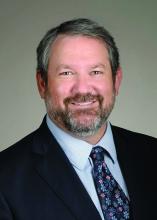Suicide prevention is a high priority for the National Institute of Mental Health (NIMH) and will be one specific area of focus in the federal agency’s 5-year strategic plan that’s set to be released soon, according to Director Joshua A. Gordon, MD, PhD.
The agency is updating its strategic plan to guide research efforts and priorities over the next 5 years, Dr. Gordon said at the annual meeting of the American Psychiatric Association, which was held as a virtual live event.
That strategic plan, which will cover a broader range of priorities, is scheduled to be published “within the next few weeks,” Dr. Gordon said.
Closing the research gap in suicide prevention is a high priority for NIMH, Dr. Gordon said, especially in light of the age-adjusted U.S. suicide rates that have been increasing consistently in men and women for the past 2 decades, as data from the Centers for Disease Control and Prevention show.
“And although we must acknowledge we don’t quite know why, there is lots of speculation and a little bit of data, but not really conclusive stuff,” he said. “We also recognize that, in addition to trying to understand why, we need to try interventions that will reverse this increase.”
Identifying those at risk for suicide is a key focus of research, according to Dr. Gordon, who highlighted results of the ED-SAFE study, describing it as a “mainstay” of approaches to reducing risk through intervention.
In that recent study, an emergency department (ED)-based suicide prevention intervention cut total suicide attempts by 30%, compared with treatment as usual (JAMA Psychiatry. 2017 Jun;74[6]:563-70). That intervention included universal suicide risk screening plus secondary screening by the physician in the ED, discharge resources, and post-ED telephone calls intended to reduce suicide risk.
The ED-SAFE study is an example of taking the lessons learned in psychiatry and bringing them to a “broader swath” of individuals who might be at risk, said Dr. Gordon, a research psychiatrist who was a faculty member at Columbia University, New York, prior to being appointed director of NIMH.
“Of course, we’d like to do this not just in emergency rooms, but in primary care offices as well,” said Dr. Gordon, who noted that ongoing studies are aimed at demonstrating similar results in primary care patient populations, including adults and children.
Beyond this ask-and-you-will-find approach, there are “more modern” methods that involve applying predictive modeling and analytics to large data sets, identifying individuals who might not otherwise be suspected as being at risk and getting them into treatment, according to the director.
In one recent report, investigators said a risk prediction method using a machine learning approach on 3.7 million patients across five U.S. health systems was able to detect 38% of suicide attempts a mean of 2.1 years in advance (JAMA Netw Open. 2020 Mar 25;3[3]:3201262).
Machine learning might be able to detect the risk of suicidal behavior in unselected patients, based on these findings and might facilitate development of clinical decision support tools for risk reduction, the investigators said.
“We’re now studying how to implement these algorithms in real-world practice,” Dr. Gordon said.
Beyond identification, new interventions are needed for suicide reduction, he added, calling ketamine infusion “one of the most promising” recent developments that may help reduce suicidal ideation.
he said. “So the question is, can we use this in real-world practice to reduce suicide risk?”
The NIMH focus on suicide prevention will intensify the agency’s focus on recent initiatives in detecting and preventing suicide behavior and ideation in the juvenile justice system, applied research toward the goal of zero-suicide health care systems, and looking at the safety and feasibility of rapid-acting interventions for severe suicide risk, among others, according to Dr. Gordon, who became director of the agency in 2016.
“We have a number of initiatives aimed at taking what we’ve learned over the past few years, and helping that have a significant public health impact,” Dr. Gordon said.
Dr. Gordon reported no disclosures.
SOURCE: Gordon JA. APA 2020, Abstract.


